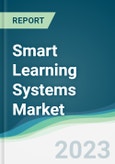The Smart Learning Systems Market Study provides a comprehensive analysis of the global smart learning systems market, offering critical insights for industry experts in education, corporate training, and technology sectors. This study explores the transformative role of smart learning systems in delivering personalized, technology-driven educational experiences, segmented by platform, product type, user type, end-user, and geography. By highlighting key market drivers, restraints, and competitive developments, the Smart Learning Systems Market Study equips stakeholders with actionable intelligence to navigate this rapidly evolving market.
Study Overview
The Smart Learning Systems Market Study delivers an in-depth examination of the smart learning systems market, covering platforms (app and website), product types (learning management systems, smart classrooms, assessment systems, adaptive learning platforms, and educational content management), user types (academic and corporate), and end-users (education, enterprise, and others). It analyzes market drivers, such as the growing adoption of AI and cloud-based technologies and the increasing demand for flexible learning solutions, alongside restraints like high implementation costs and data privacy concerns. The study incorporates Porter’s Five Forces Analysis, industry value chain insights, and strategic recommendations, with regional breakdowns across North America, South America, Europe, Middle East and Africa, and Asia Pacific, emphasizing growth opportunities in key markets like the USA and India.Competitive Environment and Analysis
In the Smart Learning Systems Market Study, the competitive environment section highlights strategic innovations from key players driving market growth. Recent developments from leading companies underscore the industry’s focus on AI integration and strategic partnerships:Adobe Inc.: In September 2023, Adobe partnered with India’s Union Education Ministry to deliver Adobe Express-based curriculum and training to schools across India, enhancing digital creativity and accessibility in K-12 education. This initiative strengthens Adobe’s position in the educational content management segment, particularly in the Asia Pacific region.
Microsoft Corporation: In October 2023, Microsoft expanded its Microsoft Learn platform with AI-powered adaptive learning modules, improving personalized learning paths for corporate training by 25%. This development reinforces Microsoft’s leadership in the corporate user segment, catering to enterprises seeking scalable training solutions.
The Smart Learning Systems Market Study also includes a market share analysis, detailing mergers, acquisitions, and collaborations, such as Anthology Inc.’s March 2024 partnership with Talisma Corporation to resell Blackboard Learn in India, expanding its reach in the learning management systems segment. The competitive dashboard provides a clear view of these dynamics, enabling industry experts to assess market positioning and strategic trends.
Conclusion
The Smart Learning Systems Market Study is an essential resource for industry experts seeking to understand the competitive and technological landscape of the smart learning systems market. By spotlighting key developments from players like Adobe Inc. and Microsoft Corporation, alongside comprehensive segmentation and regional insights, this study empowers stakeholders to make informed strategic decisions. As the demand for innovative and personalized learning solutions continues to rise, the Smart Learning Systems Market Study offers a strategic guide for capitalizing on opportunities in this dynamic and technology-driven market.Key Benefits of this Report:
- Insightful Analysis: Gain detailed market insights covering major as well as emerging geographical regions, focusing on customer segments, government policies and socio-economic factors, consumer preferences, industry verticals, and other sub-segments.
- Competitive Landscape: Understand the strategic maneuvers employed by key players globally to understand possible market penetration with the correct strategy.
- Market Drivers & Future Trends: Explore the dynamic factors and pivotal market trends and how they will shape future market developments.
- Actionable Recommendations: Utilize the insights to exercise strategic decisions to uncover new business streams and revenues in a dynamic environment.
- Caters to a Wide Audience: Beneficial and cost-effective for startups, research institutions, consultants, SMEs, and large enterprises.
What do businesses use our reports for?
Industry and Market Insights, Opportunity Assessment, Product Demand Forecasting, Market Entry Strategy, Geographical Expansion, Capital Investment Decisions, Regulatory Framework & Implications, New Product Development, Competitive IntelligenceReport Coverage:
- Historical data from 2022 to 2024 & forecast data from 2025 to 2030
- Growth Opportunities, Challenges, Supply Chain Outlook, Regulatory Framework, and Trend Analysis
- Competitive Positioning, Strategies, and Market Share Analysis
- Revenue Growth and Forecast Assessment of segments and regions including countries
- Company Profiling (Strategies, Products, Financial Information, and Key Developments among others).
Different segments covered under the smart learning systems market report are as below:
By Platform
- App
- Website
By Product Type
- Learning Management Systems (LMS)
- Smart Classrooms
- Assessment Systems
- Adaptive Learning Platforms
- Educational Content Management
By User Type
- Academic
- Corporate
By End-User
- Education
- Enterprise
- Others
By Geography
- North America
- United States
- Canada
- Mexico
- South America
- Brazil
- Argentina
- Others
- Europe
- United Kingdom
- Germany
- France
- Spain
- Others
- The Middle East and Africa
- Saudi Arabia
- UAE
- Israel
- Others
- Asia Pacific
- Japan
- China
- India
- South Korea
- Indonesia
- Thailand
- Others
Table of Contents
Companies Mentioned
- Adobe Inc.
- SMART Technologies ULC
- Microsoft Corporation
- Cisco Systems, Inc.
- SAP SE
- Dell Technologies Inc.
- Blackboard Inc.
- Pearson plc
- Samsung Electronics Co., Ltd.
- Anthology Inc.
- Coursera, Inc.
Table Information
| Report Attribute | Details |
|---|---|
| No. of Pages | 155 |
| Published | July 2025 |
| Forecast Period | 2025 - 2030 |
| Estimated Market Value ( USD | $ 59.45 Billion |
| Forecasted Market Value ( USD | $ 177.81 Billion |
| Compound Annual Growth Rate | 24.5% |
| Regions Covered | Global |
| No. of Companies Mentioned | 11 |









